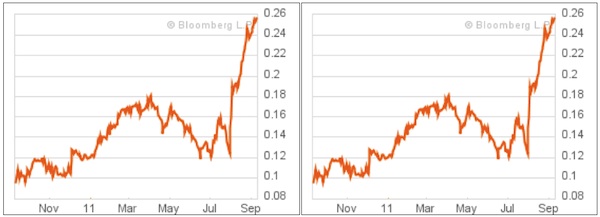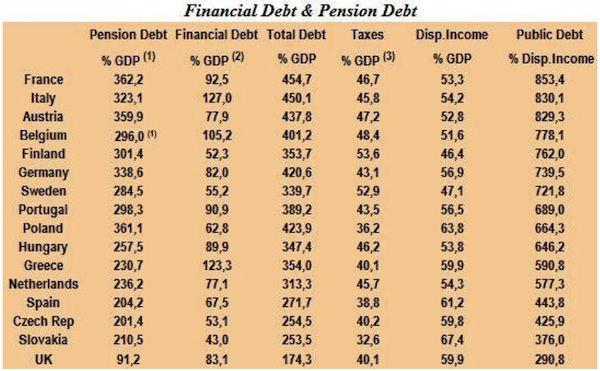A friend describes in a book he wrote about twenty five years ago, how when they were kids he and one of his friends went into a five-and-dime store and switched all the price tags! As we can understand pandemonium followed when things that were supposed to sell for $5 had a price tag of a quarter.
Over the weekend we heard news that rating agencies may be downgrading major EU banks. In the last six weeks major banks in the EU (and not only in the EU) have lost over 35% of their stock market- value. Some have lost close to half of it. In early July we wrote in a commentary that we were afraid that Italy might be hit hard, and in the days that followed major Italian banks lost significant fractions of their stock market-value. Since then, things have gotten worse for them. In the last couple of weeks due to intense market pressures the ECB has been forced to buy the bonds of Italy, Spain and other EU countries in substantial amounts as the graph below shows. However, at the same time, EU banks stock values continue their downward slide. The Bloomberg graph below shows what has been happening to EU major bank stocks especially since last May.
The declining stock prices may reflect the possibility that investors do not trust the asset side of the banks’ balance sheets and/or the profits they will be generating in the foreseeable future. Are these bank stocks becoming cheap in terms of valuation and future expectations? By some measures they may be, under a normal functioning and rational market. However, we would question the rationality of the market nowadays.
Russell Jones, head of fixed-income strategy at Australia’s second largest lender said over the weekend that EU leaders may need to bail out and even nationalize some EU banks.
The mistrust among banks is reflected in the LIBOR (London interbank offer rate) and OIS (overnight index swap rate) spread, shown below. The anxiety and lack of confidence among banks raises the spread, and thus banks are increasing their deposit with the ECB rather than lending their reserves to other banks. At the same time, the investors’ and traders’ anxiety is reflected in the TED spread (the difference between US Treasury Bill rate and the Eurodollar rate), also shown below.
LIBOR-OIS Spread and TED Spread

Now, let’s look at the CDSs costs over a 10 and a 5-year period for France.
France’s 10-Year CDS France’ 5-Year CDS

We would have expected that the 10-year cost would have been higher than the 5-year one. The inversion observed (what we call the price switching) signifies the medium-term anxiety even for an AAA country like France. Such switching we believe is typical due to the fears regarding the French banking sector. The financial and pension debt in the EU is humongous and unsustainable, and the PIGS (Portugal, Ireland, Greece and Spain) are not the worst perpetrators, as the following table shows.
What does that mean for the Euro? We wrote in a commentary on August 29 that in our opinion the price of shorting the Euro looked pretty cheap. Let’s take a look to the performance of that call since then.
Chancellor Merkel believes that joint bonds (Eurobonds) will incentivize profligate countries to stay that way. Her finance minister Mr. Schauble believes that Eurobonds are needed once the member-states have straightened up their finances, in order for EU fiscal integration to occur. For both of them it is debt and lost competitiveness that has caused the crisis.
We are of the opinion that we are dealing with a very big boat that has no anchor, has left the port and the 800-gorilla is out of his cage, while the captain has just asked the orchestra to play the prelude of a requiem.
Ode those who desire to dance while the music is playing! As for those who choose to jump …


